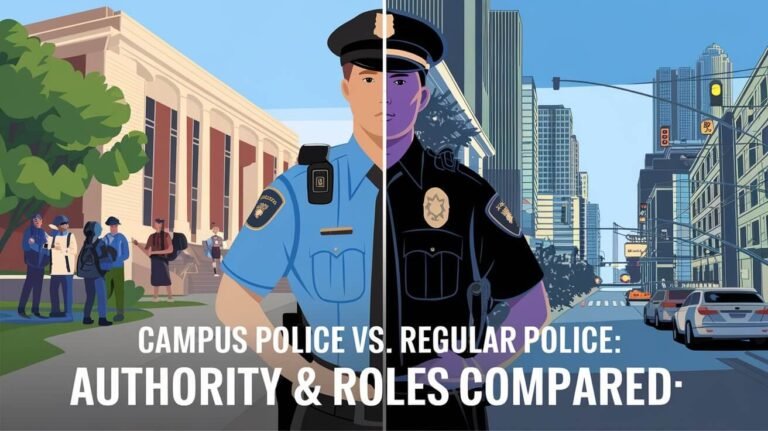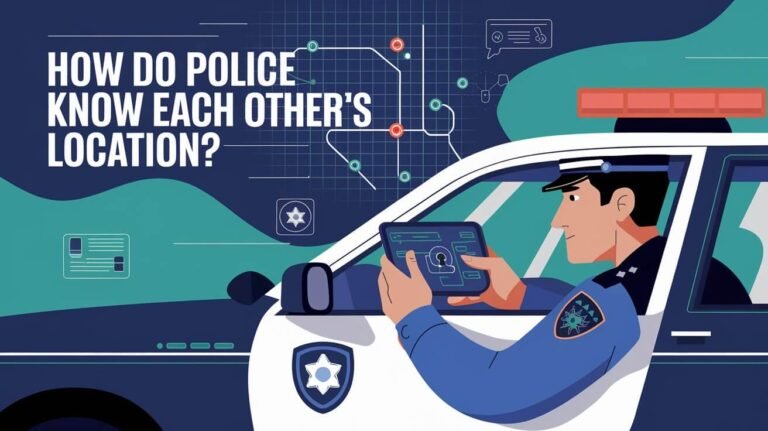Police Radio Frequencies: Allocation & Usage – Details

Police radio frequencies are key for law enforcement and public safety. They help emergency responders talk quickly and clearly. Local police and fire use frequencies between 450 and 464 MHz, like 453.480 MHz.
This shows how vital police radio frequencies are. They help emergency teams work together fast.
In the U.S., police and fire use these frequencies for quick communication. With more encrypted digital radios, it’s important to know about new police radio updates. Devices like the Baofeng BF-F8HP can handle local, GMRS/FRS, and NOAA frequencies. This makes them useful for public safety.
Radio Frequency Basics for Law Enforcement
Law enforcement agencies use radio frequency basics to talk to each other. They use different bands like VHF and UHF. VHF goes from 30MHz to 300MHz, with a special range for land mobile radios from 136-174MHz.
UHF has its own ranges for land mobile radios: 403-430MHz, 450-470MHz, and 450-512MHz.
It’s important to know the difference between trunked and conventional systems. Trunked systems let many agencies share the same frequency. Conventional systems give a specific frequency to one agency. Digital signals give better sound and security, but analog signals can get interrupted more easily.
Some key frequencies for law enforcement include:
- 39.46000 MHz – LLAW 1
- 453.21250 MHz – UCALL40 (Calling)
- 770.39375 MHz – 7LAW61 (Law Enforcement)
These frequencies are for dispatch, tactical operations, and emergencies. The Federal Communications Commission (FCC) makes sure these frequencies are used right. This helps avoid interference.
| Frequency Band | Designation | Usage |
|---|---|---|
| VHF | 136-174MHz | Land mobile radios |
| UHF | 403-430MHz, 450-470MHz, 450-512MHz | Land mobile radios |
| 700MHz | 758-763MHz / 788-793MHz | Public safety broadband network |
Learning about radio frequency basics, law enforcement can improve their communication. This makes sure they can talk securely and effectively during operations.
Common Police Radio Frequencies Across States
Police radio frequencies are key for law enforcement and public safety. Different states use various frequencies for communication and emergency response. It’s important to manage these frequencies well for effective communication among agencies.
In the U.S., the 700 MHz Public Safety Band Plan is used for public safety. This plan is vital for communication among law enforcement, fire departments, and EMS. EMS frequencies are standardized across many states for better communication.
Some common police radio frequencies include:
- 39.460 MHz
- 39.480 MHz
- 45.860 MHz
- 45.880 MHz
These frequencies are for law enforcement communication. The FCC allocates them. Trunked radio systems and digital encryption are also used more often.
FEMA has its own frequency list for disaster response. The 220-222 MHz Band Plan is used in various U.S. civilian applications. The 421-430 MHz Band is for specific radio communication in the U.S. The 900 MHz LMR Band Plan is for Land Mobile Radio systems in the U.S.
| Frequency Band | Allocation |
|---|---|
| 700 MHz | Public Safety Band Plan |
| 220-222 MHz | U.S. civilian applications |
| 421-430 MHz | Specific radio communication purposes |
| 900 MHz | Land Mobile Radio systems |
Knowing police radio frequencies is key for communication and safety. The FCC allocates specific bands for law enforcement and public safety. This ensures emergency responders can communicate well and respond quickly to emergencies.
Scanner Technology and Equipment
Scanner technology has changed a lot over time. Today’s scanners can handle thousands of channels and check hundreds of channels every second. They also come with mobile apps and software for easy use.
For the best scanner performance, reception tools are key. They boost signal strength and clarity. This lets users catch signals from more frequencies. Tools like external antennas, signal amplifiers, and noise filters are popular.
Digital Scanner Models
Digital scanners have cool features like trunking. This lets many users share one frequency. They can also decode digital signals like APCO-P25 and store lots of channels. The Uniden BCD536HP and Whistler WS1040 are top picks.
Mobile Apps and Software
Mobile apps and software have changed how we use scanners. They let users program and control scanners. They also offer lots of features and functions. Apps like Scanner Radio and Butel ARC536 software are favorites.
| Scanner Model | Features | Price |
|---|---|---|
| Uniden BCD536HP | Trunking, APCO-P25 decoding, 3000 channels | $500 |
| Whistler WS1040 | Trunking, APCO-P25 decoding, 2000 channels | $400 |
Scanner tech and gear have improved a lot. With the right scanner, app, and software, users can get the most out of their scanning. This keeps them updated with the latest scanner tech.
Legal Framework for Radio Monitoring
The rules for radio monitoring are complex and cover many areas. They involve laws and regulations for police radio use. These rules help keep the public safe and ensure good communication.
The Federal Communications Commission (FCC) is key in setting these rules. It makes sure police follow strict guidelines.
In California, there are 13 CALAW channels for public safety. These channels must follow strict rules set by Cal OES. The FCC also made states plan their 800 MHz radio systems regionally.
Some important parts of the radio monitoring laws include:
- Authorization: Police need FCC permission to use certain frequencies.
- Compliance: They must follow strict rules, like frequency coordination.
- Public Safety: Emergency calls get priority.
- Interoperability: This helps different police groups talk smoothly.
Cal OES Telecommunications Branch oversees CALAW’s technical standards. This ensures police follow the rules. The FCC’s Safety of Life rule lets police use radios in emergencies. Knowing these laws helps police communicate better, keeping everyone safe.
| Agency | Frequency | Authorization |
|---|---|---|
| Los Angeles County Sheriff’s Department | 800 MHz | FCC |
| California Highway Patrol | 700 MHz | Cal OES |
Decoding Police Radio Codes
Understanding police radio codes is key to grasping law enforcement communication. The most common codes are the ten-codes, which are easy to spot. These codes help send messages fast and are vital in emergencies. Agencies also use their own signals and emergency codes to talk and act in emergencies.
To crack police radio codes, knowing the different types is essential. Ten-codes are the most widespread and used for messages like “10-4” for “message received” or “10-20” for “location”. Agencies have their own signals and use special codes for emergencies.
Understanding Ten-Codes
Ten-codes are the most common and easy to recognize. They help send messages quickly and are key in emergencies. Some common ones include:
- 10-4: Message received
- 10-20: Location
- 10-28: Vehicle registration check
Department-Specific Signals and Emergency Response Codes
Agencies use their own signals to talk to each other, and special codes for emergencies. These codes are not as standard as ten-codes but are vital for police communication. Learning to decode these can be tough, but it’s important to understand how police talk to each other.
| Code | Meaning |
|---|---|
| 10-4 | Message received |
| 10-20 | Location |
| 10-28 | Vehicle registration check |
Reception Improvement Methods
For law enforcement to communicate well, they need reliable police radio frequencies. There are ways to make police radios work better. Using antennas, amplifiers, and other tools can help scanners perform well and keep public safety high.
When trying to improve reception, consider a few things. The type of radio frequency matters, as does the radio’s power output. Also, interference from other devices can affect how well you hear.
Digital radios are better at reaching far distances and keeping sound clear. Antennas and amplifiers can also help a lot, where signals are weak. Keeping radios in good shape is key. Make sure batteries are fresh and avoid interference from other electronic devices.
| Reception Improvement Method | Description |
|---|---|
| Antenna Upgrade | Upgrading to a high-gain antenna can improve reception by increasing the signal strength |
| Amplifier Installation | Installing an amplifier can boost the signal strength, resulting in better reception |
| Regular Maintenance | Regularly maintaining and replacing aging batteries can ensure optimal radio performance |
Digital Encryption in Modern Communications
Digital encryption is key to keeping modern communications safe, like in public safety. It makes sure sensitive info stays hidden from prying eyes. In public safety, help keep emergency talks secure.
There are many encryption types out there, like partial and full encryption. The top encryption for federal radios is AES 256, seen as very secure. The Federal Partnership suggests using the National Law Enforcement Communications Center for key generation.
Future Technologies and Encryption
As tech gets better, so will the need for digital encryption. New encryption and secure ways to talk will be vital for keeping info safe. Digital encryption is a must for stopping info leaks and keeping public safety strong.
Some cities are already using encrypted police radios. For example:
- New York City, with 20% of its frequencies encrypted
- Los Angeles, with 20% of its frequencies encrypted
- Chicago, with 10% of its frequencies encrypted
These cities show how encryption levels vary. They point out the need for a clear plan for using encryption.
Regional Frequency Allocation Maps
Regional frequency allocation maps are key for managing police radio frequencies. They help ensure law enforcement can talk to each other well. These maps assign specific frequencies to public safety, federal agencies, and amateur radio users.
Planners work hard to avoid interference. They make sure each group can talk without problems. For instance, land mobile services use frequencies from 30 MHz to 300 MHz. Mobile satellite services get frequencies from 1610 MHz to 1626.5 MHz.
Here are some important frequency ranges and their uses:
- 5.68 MHz to 30.0 GHz: allocated for various services, including public safety and federal agencies
- 156.000 MHz to 162.025 MHz: allocated for maritime mobile communication
- 108.00 MHz to 118.00 MHz: used for aeronautical radionavigation beacons
These maps are vital for law enforcement to handle emergencies and keep people safe. Knowing how frequencies are managed helps agencies talk better and respond faster. This can save lives.
| Frequency Range | Allocation |
|---|---|
| 5.68 MHz to 30.0 GHz | Public safety and federal agencies |
| 156.000 MHz to 162.025 MHz | Maritime mobile communication |
| 108.00 MHz to 118.00 MHz | Aeronautical radionavigation beacons |
Scanner Programming Steps
Programming a scanner starts with a basic setup guide. You need to install software and connect the scanner to a computer. For example, Uniden offers free software like Sentinel for models like the SDS100 and BCD436HP. Whistler also has EZ Scan Software for the TRX-1 and TRX-2.
Getting frequencies from a reliable database like Radio Reference is key. Users can enter their zip code to get local frequencies. It’s important to know that frequencies can be conventional or trunked, and some may be encrypted or simulcast. Advanced steps might include backing up files and updating software.
Some scanners come with software and frequencies, while others need to be bought separately. For example, the SDS100 and HomePatrol-2 come with software, but the BC355N and SR30C don’t. Knowing what each model needs is important for effective programming. By following a basic guide and advancing to more complex steps, users can make their scanner work better for communication and public safety.
Interference Prevention Techniques
Keeping communication clear is key for law enforcement and public safety. To avoid disruptions, it’s vital to prevent interference. This ensures that police radios work well, keeping everyone safe.
Interference can come from many places, like other transmitters or even the weather. To fight this, police use special tools and check their gear often. This helps them stay connected without trouble.
Working together is also important. Police, public safety groups, and others must team up. This way, they can find and fix problems before they cause big issues.
Some key ways to stop interference include:
- Using frequency allocation maps to find and avoid interference
- Adding encryption to keep radio signals safe
- Testing and fixing equipment regularly
- Collaborating with others to share strategies
Using these methods, police can keep their radios clear. This helps them do their job better and keeps everyone safe.
| Interference Prevention Strategy | Description |
|---|---|
| Frequency Allocation Maps | Identify and avoid interference sources |
| Encryption and Security Measures | Keep radio signals safe from unauthorized access |
| Regular Testing and Maintenance | Keep equipment working well and find problems early |
| Collaboration and Coordination | Work together to solve interference issues |
Final Verdict
Police radio frequencies are key to keeping us safe and helping police respond quickly to emergencies. New tech, like digital systems and encryption, shows we need a smart balance. This balance must protect us while also tackling new security issues.
The debate over encryption is important. We need a way to keep info safe but also let the media and public watch important events. It’s about finding a fair middle ground. This way, police radio frequencies can stay open to those who need them to stay informed.
World of police radio frequencies is changing fast. It’s up to law enforcement, policymakers, and us to make sure we move forward wisely. By using new tech and keeping communication open, we can make sure police radio frequencies keep protecting and serving our communities.






